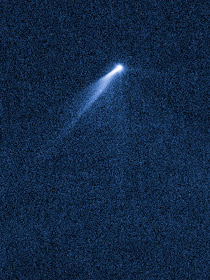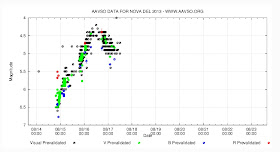We obtained further follow-up on
C/2012 S1 (ISON) on 2013, Oct. 1.2, through the 2.0-m f/10.0 Ritchey-Chretien + CCD + SDSS r' Filter of
Liverpool Telescope (MPC code J13).
Stacking of 20 exposures, 11-seconds each, produced an image where is visible a well developed coma and tail measuring at least 3 arcmin extended toward PA 297 deg. Click on the image for a bigger version.
Below another elaboration of the same stacking. Click on it for a bigger version.
Just out of curiosity, in this ISON field there are 2 known asteroids (31176) 1997 XL9 (magnitude ~18) & (11293) 1991 XL (magnitude ~18.5). We have highlighted here the position of the asteroids:
In the image below you can see 3 different elaborations of the ISON inner coma. The first panel on the left is a
Larson-Sekanina filter. In the middle panel elaboration with the MCM filter creates an artificial coma, based on the photometry of the original image, and subtract the original image itself in order to highlight the internal zones of different brightness that are very close to the inner core and that would normally be hidden from the diffuse glow of the comet. While the last panel on the right is the elaboration with filter RWM - 1/r theoretical coma subtraction.
Af[rho is a proxy of dust abundance within the coma. It was introduced by Michael A'Hearn et al. in 1984 (AJ 89, 579, 1984) with the aim of comparing measurements concerning the dust continuum under different observing conditions, times and instruments.
A first result obtained by
CARA team from a preliminary analysis on comet ISON is shown in the two plots below: one concerning the observed Af[rho]quantity (where is evident an apparent peak related to the phase effect) and another with the log(Afrho) quantity corrected for the solar phase effect. Click on the images for a bigger version.
On our data of October 01, 2013 we measured an Af[rho] value about 350 cm, for a corresponding aperture of nearly 20,000 km in diameter at the comet distance, confirming the fading trend. Click on the image for a bigger version.
UPDATE - October 05, 2013
We obtained new data on comet C/2012 S1 (ISON) on October 04, 2013. The details are on the caption of the image below.
UPDATE - October 06, 2013
We obtained new data on comet C/2012 S1 (ISON) on October 05, 2013. The details are on the caption of the image below.
UPDATE - October 07, 2013
We obtained new data on comet C/2012 S1 (ISON) on October 07, 2013. The details are on the caption of the image below.
UPDATE - October 08, 2013
Here we present a preliminary analysis with respect to a sunward facing feature detected on comet C/2012 C1 (ISON) The feature imaged between 30th Sept 2013 and 7th Oct 2013 is clearly visible and reproducible in images taken over four observing nights we had with the 2.0 m. Liverpool Telescope between these dates.
All images have the same integrated exposure time (being a sum of 20x11sec.=220sec at 2x2 binning on the CCD, yielding a pixel resolution of 0.3”/pixel.) In all image the same filter (SDSS R' band) and exactly the same false-color scale visualization using Astroart software has been deployed.
After the usual dark subtraction and flat field correction using field data provided by the Liverpool Telescope (as on some nights, automatic calibration was not performed) and stacking on the photometric centre of the coma, we built a radial normalization model of the coma suing a plug in developed for this purpose within Astroart (The plug in is known as the M.C.M. or Median Coma Model). With this , we then subtracted the modelled image from the original image data to enhance any difference between the real and the "ideal modelled" coma.
The results of this processing is shown in the four images detailed below. Each square is a zoomed in view of the full image, and each image is 30" wide, with each rectangular white grid scaled to 7.5"x10". The white pixel in the centre of each image is the brightest pixel inside the coma, known as the optocenter.
The sunward facing feature, feature shows a maximum size on data taken on the 7th Oct reaching out to about 2.7 arcsec (about 4500 km at the projected plate scale) and also is notably almost absent on data taken on the 4 Oct, which we believe is due to adverse seeing conditions on this date at our site on La Palma. The seeing conditions for each night as measured are :1 Oct/1.1" arcsec, 4 Oct/2.1" arcsec, 5 and 7 Oct. 1.5" arcsec.
At this plate scale the sunward facing feature we believe cannot be associated with any degree of confidence with any nuclear phenomenon (eg/jets) but after careful analysis, we now believe it to be a typical cometary coma condensation. We therefore state that this feature is a cometary atmosphere feature present in almost all comets approaching the Sun and the Earth.
UPDATE - November 06, 2013
We obtained new data on comet C/2012 S1 (ISON) on November 04, 2013. The details are on the caption of the image below.
UPDATE - November 11, 2013We obtained new data on comet C/2012 S1 (ISON) on November 11, 2013. DDP processed on the image to enhance the core of the coma and the thin second tail. The details are on the caption of the image below.
by Nick Howes, Ernesto Guido and Martino Nicolini

















































.bmp)






